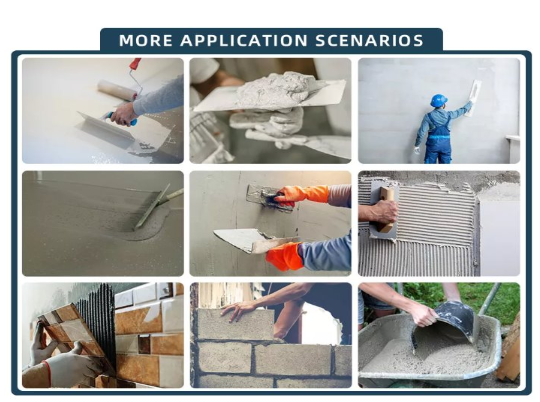Hydroxypropyl methylcellulose (HPMC) is a key additive in cement-based building materials and mortar, offering numerous benefits that enhance the properties and performance of these materials. As a cellulose ether derivative, HPMC is valued for its ability to modify the rheological properties, improve workability, and provide critical functional benefits in cement-based systems. This article explores the role and advantages of using HPMC cellulose in cement-based building materials and mortar.
1. Water Retention
Role: HPMC significantly improves the water retention capacity of cement-based mortars.
Benefits:
- Optimal Hydration: HPMC helps maintain the necessary water content during the hydration process, ensuring the cement fully reacts. This leads to improved strength and durability of the mortar.
- Reduced Drying Shrinkage: By retaining water, HPMC minimizes the risk of drying shrinkage, which can cause cracks and reduce the longevity of the construction.
2. Enhanced Workability
Role: HPMC improves the consistency and workability of cement-based materials.
Benefits:
- Smooth Application: It ensures a smooth, lump-free mix, making the application process easier and more efficient.
- Better Trowelability: The modified rheological properties provide an ideal balance between viscosity and flow, allowing for easy spreading and shaping of the mortar.
3. Extended Open Time
Role: HPMC extends the open time of cement-based materials.
Benefits:
- Increased Adjustability: Workers have more time to apply and adjust the material, which is particularly useful in complex installations where precision is required.
- Reduced Waste: The extended open time helps in reducing material waste, as there is less risk of the mixture setting before it is used.
4. Improved Adhesion and Cohesion
Role: HPMC enhances the adhesive properties of cement-based materials.
Benefits:
- Stronger Bond: It improves the bond strength between the mortar and substrates, such as bricks, concrete, and tiles, ensuring a durable attachment.
- Reduced Segregation: HPMC prevents the segregation of components in the mix, ensuring a uniform distribution of materials and consistent quality.
5. Anti-Sagging Properties
Role: HPMC provides anti-sagging properties in cement-based materials.
Benefits:
- Stability: It prevents the slumping or sagging of mortar in vertical applications, such as wall rendering or tile installation.
- Enhanced Safety: The anti-sagging effect ensures that materials stay in place during the setting process, reducing the risk of accidents and rework.
6. Crack Resistance and Flexibility
Role: HPMC enhances the flexibility and crack resistance of cement-based mortars.
Benefits:
- Durability: The increased flexibility helps absorb minor movements and thermal expansions in the substrate, reducing the likelihood of cracks.
- Longevity: This crack resistance contributes to the long-term durability and aesthetic quality of the construction.
7. Improved Finish and Surface Quality
Role: HPMC contributes to a finer finish and improved surface quality.
Benefits:
- Smooth Surface: It helps achieve a smooth, even surface, which is essential for both aesthetic appeal and the performance of subsequent coatings or finishes.
- Reduced Efflorescence: By controlling water retention and evaporation rates, HPMC helps prevent the formation of efflorescence, which can discolor and damage surfaces.
8. Environmental and Safety Benefits
Role: HPMC is a non-toxic, biodegradable additive derived from natural cellulose sources.
Benefits:


